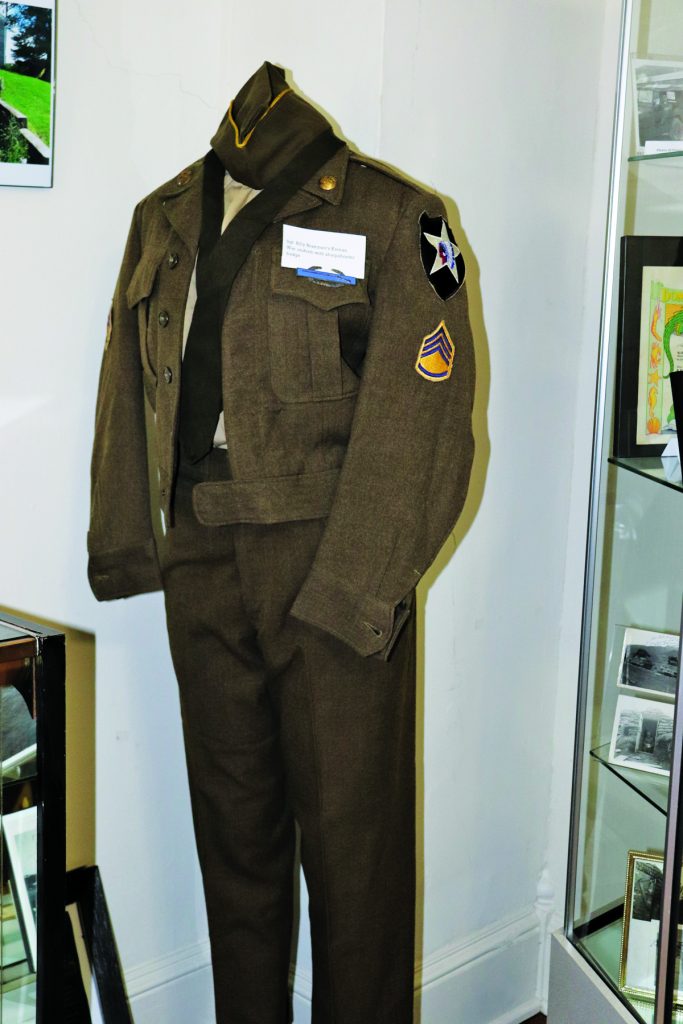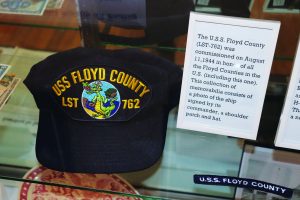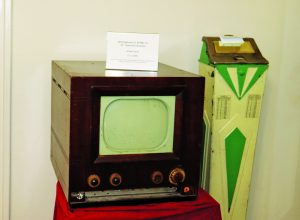
The Korean War uniform of Floyd County native, Billy Brammer.
By Sheilah Elwardani
The current exhibit at the Floyd Historical Society explores the dynamic world of 1950’s America in Floyd County and honors the men who served in the Korean War. The end of World War II brought tremendous change to the United States and the world: new global threats, economic growth on an unprecedented scale, and the U.S. emergence as a global peace-keeping force bent on stopping the threat of communism. Also, domestically dramatic shifts in gender roles and racial desegregation began to offer opportunities previously denied to some groups. The Floyd County Historical Society brings this dynamic period to life through the experience of Floyd’s citizens in the post-WWII era.
For the American citizen, the 1950’s brought hope and prosperity on a previously unimaginable scale. Meanwhile, for the American soldier serving on the Korean peninsula, the threat of communist expansion became a cold, hard reality in a brutally hot war.
 The service hat from the U.S.S. Floyd County. This ship was commissioned in 1944 and delivered the first nuclear bomb to the Pacific.events perched on this bench and chatting with friends and family.
The service hat from the U.S.S. Floyd County. This ship was commissioned in 1944 and delivered the first nuclear bomb to the Pacific.events perched on this bench and chatting with friends and family.
Going back to April 12, 1945, Harry Truman had no idea that he would approve the dropping of the atomic bombs on Japan when he was sworn into office. The exhibit at the Floyd County History Museum begins with the ending of the war in the Pacific.
The U.S.S. Floyd County was commissioned on August 11, 1944 in recognition of all the Floyd Counties in the United States, and it was this ship that transported the first atomic bomb to the Pacific Theater in anticipation of Japan refusing a peaceful surrender.
The exhibit features the hat of a Floyd County Navy veteran who served on the U.S.S. Floyd, attending the delivery of the bomb. At the time, the shipmen certainly had no idea of the magnitude of the cargo they carried. The exhibit then leads the visitor through the military and developing Cold War period which culminated in the Korean Conflict.
Floyd County lost at least two servicemen in the Korean War. Private First Class, Rufus Pleasant Craighead was killed in action during the retreat from the Chosin Reservoir. His body was never recovered. Carl Lawson was killed in action in May of 1953, just one month before the armistice was signed that ended the conflict in practice. It’s a matter of record, however, that no official peace declaration was ever signed. The uniform of Floyd County Korean War veteran, Billy Brammer, will be on display, as well as photos of several more Floyd County servicemen.
 The exhibit explores the products and devices which first entered the American home in the post WWII years. The war effectively, and finally, ended the Great Depression, and the post-war years saw a booming U.S. economy fueled by massive, war-time industrial expansions. A consumer economy developed rapidly as a growing portion of the population earned an income high enough to purchase new luxury goods. Cars, washing machines, vacuum cleaners, and hair dryers found their way into American homes. The exhibit features many of the new items which dramatically changed American life: home hair dryers, roller skates, and the arrival of a television set in nearly every American home.
The exhibit explores the products and devices which first entered the American home in the post WWII years. The war effectively, and finally, ended the Great Depression, and the post-war years saw a booming U.S. economy fueled by massive, war-time industrial expansions. A consumer economy developed rapidly as a growing portion of the population earned an income high enough to purchase new luxury goods. Cars, washing machines, vacuum cleaners, and hair dryers found their way into American homes. The exhibit features many of the new items which dramatically changed American life: home hair dryers, roller skates, and the arrival of a television set in nearly every American home.
The booming economy brought a multitude of new products into the American home, including hair dryers and vacuum cleaners.
The exhibit then turns the visitors’ attention to the Polio outbreaks which raged across the globe during the early to mid-1900s. Although the presence of the virus has been recorded throughout human history, a means of identifying and preventing the virus had been beyond the reach of medicine until the 1950’s. The development of sterilizing vaccines for deadly viruses such as smallpox, however, finally led to the medical breakthrough of a sterilizing vaccine to prevent polio. This vaccine first became available to American, and Floyd citizens in 1955.
 Televisions arrived in the American home bringing new traditions for families across the nation. The Wonderful World of Disney aired on Sunday evenings, bringing advertisements for enticing products to a growing consumer society.
Televisions arrived in the American home bringing new traditions for families across the nation. The Wonderful World of Disney aired on Sunday evenings, bringing advertisements for enticing products to a growing consumer society.
Floyd County doctors led the charge to protect children from the often-disabling disease. Floyd County’s own Ellen Walach Vest became the poster child for the March of Dimes; an organization dedicated to supporting children and families impacted by polio. The exhibit explores the impacts of polio on Floyd County and the work of local doctors, as well as the March of Dimes, in the effort to end polio in the nation.
The current exhibit honors and celebrates and brilliant, vital, and often sobering history of the 1950’s in Floyd County while honoring the men who served with valor on the Korean Peninsula. This exhibit walks visitors through the history of the post-World War II years, beginning with delivery of the first atomic bomb to the Asian theater on board the U.S.S. Floyd, then progressing through the Korean War and Floyd County’s contribution to the war effort. Visitors will then explore the changing of life and developing consumer culture which blossomed in 1950’s America.
 The rotary phone, party lines, and the ‘gossip bench’. Floyd County native, Connie Mitchell, remembers her mother keeping abreast of current Floyd County events while perched on this bench and chatting with friends and family.
The rotary phone, party lines, and the ‘gossip bench’. Floyd County native, Connie Mitchell, remembers her mother keeping abreast of current Floyd County events while perched on this bench and chatting with friends and family.
“This exhibit allows you to step back in time and imagine life in Floyd County during the Truman and Eisenhower years. From the building of backyard bomb shelters under the fear of nuclear attack, to the social struggle to desegregate schools, this exhibit will take you back to 1950’s Floyd and illuminate the good, the bad, the heartbreaking, and the hope-giving world of 1950’s America.”
This exhibit will be available for viewing at 217 North Locust Street in Floyd. The museum is open April through December: Thursdays and Fridays from 12:00pm to 4:00pm, and Saturdays from 11:00am to 3:00pm.
Due to the impacts of the Covid 19 pandemic the current exhibit will continue to grow and evolve through the Summer and Fall of 2022. Be sure to stop in and explore this rich period in American, and Floyd County, history.
The Floyd County Historical Society
217 North Locust Street, Floyd, VA
www.floydhistoricalsociety.org • 540-745-3247
info@floydhistoricalsociety.org
